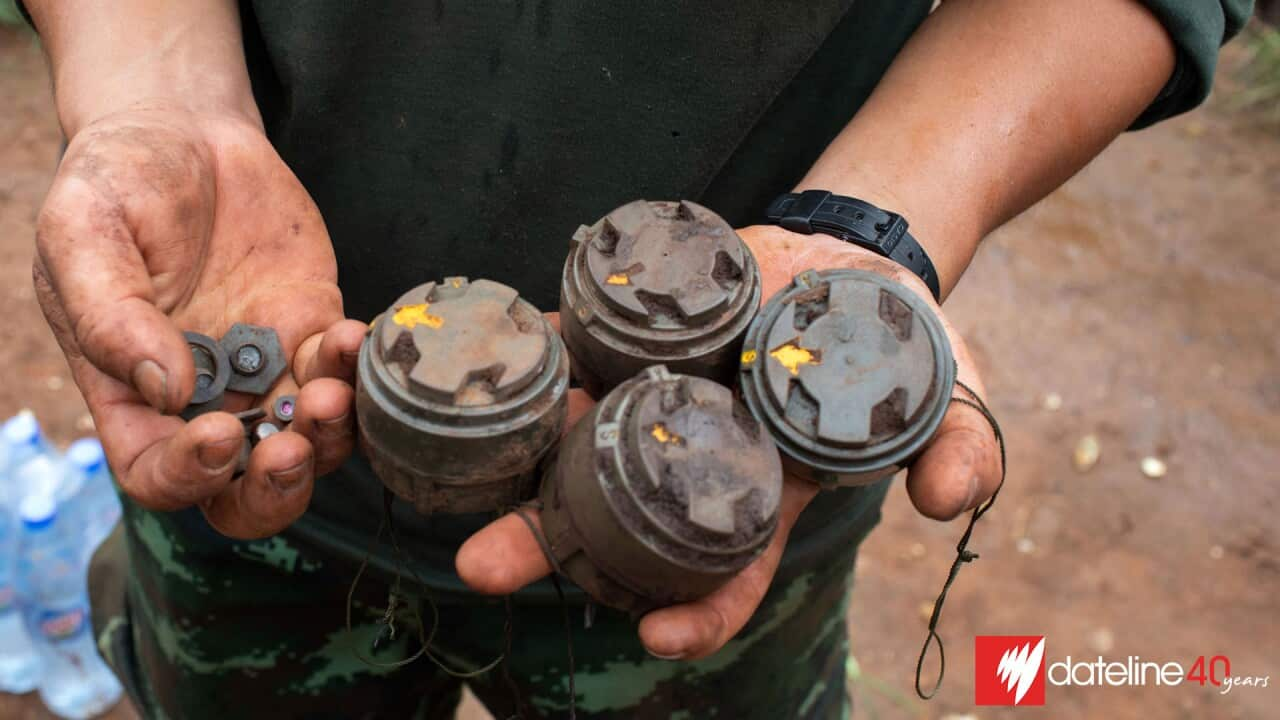The World Health Organization (WHO) says the Myanmar earthquake is a top-level emergency as it urgently seeks $8 million to save lives and prevent disease outbreaks over the next 30 days.
The toll from Myanmar's earthquake continued to rise overnight, as foreign rescue teams and aid rushed into the impoverished country, where hospitals were overwhelmed and some communities scrambled to mount rescue efforts with limited resources.
The initial 7.7-magnitude quake struck near the central Myanmar city of Mandalay on Friday, followed minutes later by a 6.7-magnitude aftershock. The quake has killed more than 1,700 people in Myanmar and at least 18 in neighbouring Thailand.
Rescuers freed a woman from the ruins of a hotel in Mandalay, officials said on Monday, a glimmer of hope for the many unaccounted for believed to be under the rubble of buildings.
In Bangkok, Thailand's capital, emergency crews on Monday resumed a desperate search for 76 people believed buried under the rubble of an under-construction skyscraper that collapsed.
After nearly three days, fears were growing that the rescuers would find more dead bodies, which could sharply raise Thailand's death toll, which stood at 18 on Sunday.

The earthquake has killed more than 1,700 people. Source: AAP / Stringer/EPA
"WHO has classified this crisis as a Grade 3 emergency — the highest level of activation under its Emergency Response Framework," the United Nations health agency said in its flash appeal for funds.
In Myanmar, "preliminary assessments indicate high numbers of casualties and trauma-related injuries, with urgent needs for emergency care. Electricity and water supplies remain disrupted, worsening access to health services and heightening risks of waterborne and food-borne disease outbreaks," the WHO said.
"Trauma-related injuries — including fractures, open wounds, and crush syndrome — are at high risk of infection and complications due to limited surgical capacity and inadequate infection prevention and control."
WHO says it needs $12 million
The WHO said it needed US$8 million ($12.7 million) to respond to the immediate health needs over the next 30 days, "to save lives, prevent disease, and stabilise and restore essential health services".
"Without immediate funding, lives will be lost and fragile health systems will falter."
The WHO said hospitals were overwhelmed, while the scale of deaths, injuries and damage to health facilities "are not yet fully understood".
The agency said displacement into overcrowded shelters, combined with the destruction of water systems and sanitation infrastructure, had sharply increased the risk of communicable disease outbreaks.
"This earthquake strikes amid an already dire humanitarian context marked by widespread displacement, fragile health systems, and disease outbreaks — including cholera," it said.
"Immediate health needs include trauma and surgical care, blood transfusion supplies, anaesthetics, and essential medicines. "Disease surveillance must be urgently strengthened to prevent outbreaks of cholera, dengue, and other communicable diseases."
Australian agencies unite for joint fundraising appeal
In the wake of the earthquake, a collective of major Australian aid agencies have agreed to work together to raise funds for those impacted.
The Emergency Action Alliance's members include ActionAid Australia, Act For Peace, ADRA, Anglican Overseas Aid, Australia for UNHCR, Australian Lutheran World Service, Baptist World Aid Australia, CARE Australia, Caritas Australia, CBM Australia, ChildFund Australia, Oxfam Australia, Plan International Australia, Save the Children Australia, and Tearfund Australia.
The group over the weekend, with executive director Kerren Morris saying: "Right now EAA member organisations are working with their local partners on the ground to provide immediate, life-saving aid to the disaster response, including search and rescue efforts as people remain trapped in the rubble.
"They are doing all they can, but we urgently need donations to help those who will need shelter, food, and other assistance. We are urging Australians to give whatever they can to help."

A woman injured by Friday's earthquake waits to receive treatment at the hospital in Naypyitaw, Myanmar on Saturday. Source: AAP / Aung Shine Oo / AP
Junta criticised for conducting strikes
An armed resistance movement against Myanmar's military-run government has criticised the junta for conducting air strikes on villages even as the country reels from the earthquake.
The Karen National Union (KNU), one of Myanmar's oldest ethnic armies, said in a statement that the junta "continues to carry out air strikes targeting civilian areas, even as the population suffers tremendously from the earthquake".
The group said that under normal circumstances, the military should be prioritising relief efforts, but instead is focused on "deploying forces to attack its people".
A spokesperson for the junta did not reply to queries from Reuters about the criticism.
Myanmar has been locked in civil war with multiple armed opposition groups since a 2021 coup, when the military seized power from the elected government of Nobel Peace Prize laureate Aung San Suu Kyi.
Shortly after Friday's devastating earthquake, military jets launched air strikes and drone attacks in Karen state, near the KNU headquarters, according to the Free Burma Rangers, a relief organisation.
The epicentre of the quake was in an area held by junta forces, but the devastation is widespread and also affected some territory held by armed resistance movements.
On Sunday, the opposition National Unity Government, which includes remnants of the government ousted in 2021, said anti-junta militias under its command would pause all offensive military action for two weeks.
Richard Horsey, the senior Myanmar adviser at Crisis Group, a non-profit that aims to prevent wars, said some anti-junta forces have halted their offensives, but fighting continues elsewhere.
"The regime also continues to launch air strikes, including in affected areas. That needs to stop," he said. He added that the regime was not providing much visible support in quake-hit areas.
"Local fire brigades, ambulance crews, and community organisations have mobilised, but the military — who would normally be mobilised to support in such a crisis — are nowhere to be seen," Horsey said.
The junta chief, senior general Min Aung Hlaing, warned that the number of deaths could go up and his administration faced a challenging situation, state media reported, three days after he made a rare call for international assistance.
India, China and Thailand are among Myanmar's neighbours who have sent relief materials and teams, along with aid and personnel from Malaysia, Singapore and Russia.
"The destruction has been extensive, and humanitarian needs are growing by the hour," the International Federation of Red Cross and Red Crescent Societies said in a statement.

The powerful quake has destroyed infrastructure, homes and transport networks. Source: SIPA USA / Teera Noisakran
Critical infrastructure — including bridges, highways, airports and railways — across the country of 55 million people lie damaged, slowing humanitarian efforts.
In some areas near the epicentre, residents told Reuters that government assistance was scarce, leaving people to fend for themselves.
In Mandalay, scores of people were feared trapped under collapsed buildings, and most could not be reached or pulled out without heavy machinery, two humanitarian workers and two residents said.
"My teams in Mandalay are using work gloves, ropes and basic kits to dig and retrieve people," one humanitarian worker said.
"There are countless trapped and still missing. The death toll is impossible to count at the moment."
In Bangkok, at the site of the collapsed 33-storey building, rescuers surrounded by shattered concrete piles and twisted metal continued their efforts to rescue dozens of workers trapped under the rubble.
Readers wanting to donate to Emergency Action Alliance's Myanmar earthquake appeal can do so or by calling 1300 939 000.


